sensor TOYOTA PRIUS C 2019 (in English) User Guide
[x] Cancel search | Manufacturer: TOYOTA, Model Year: 2019, Model line: PRIUS C, Model: TOYOTA PRIUS C 2019Pages: 596, PDF Size: 10.42 MB
Page 225 of 596
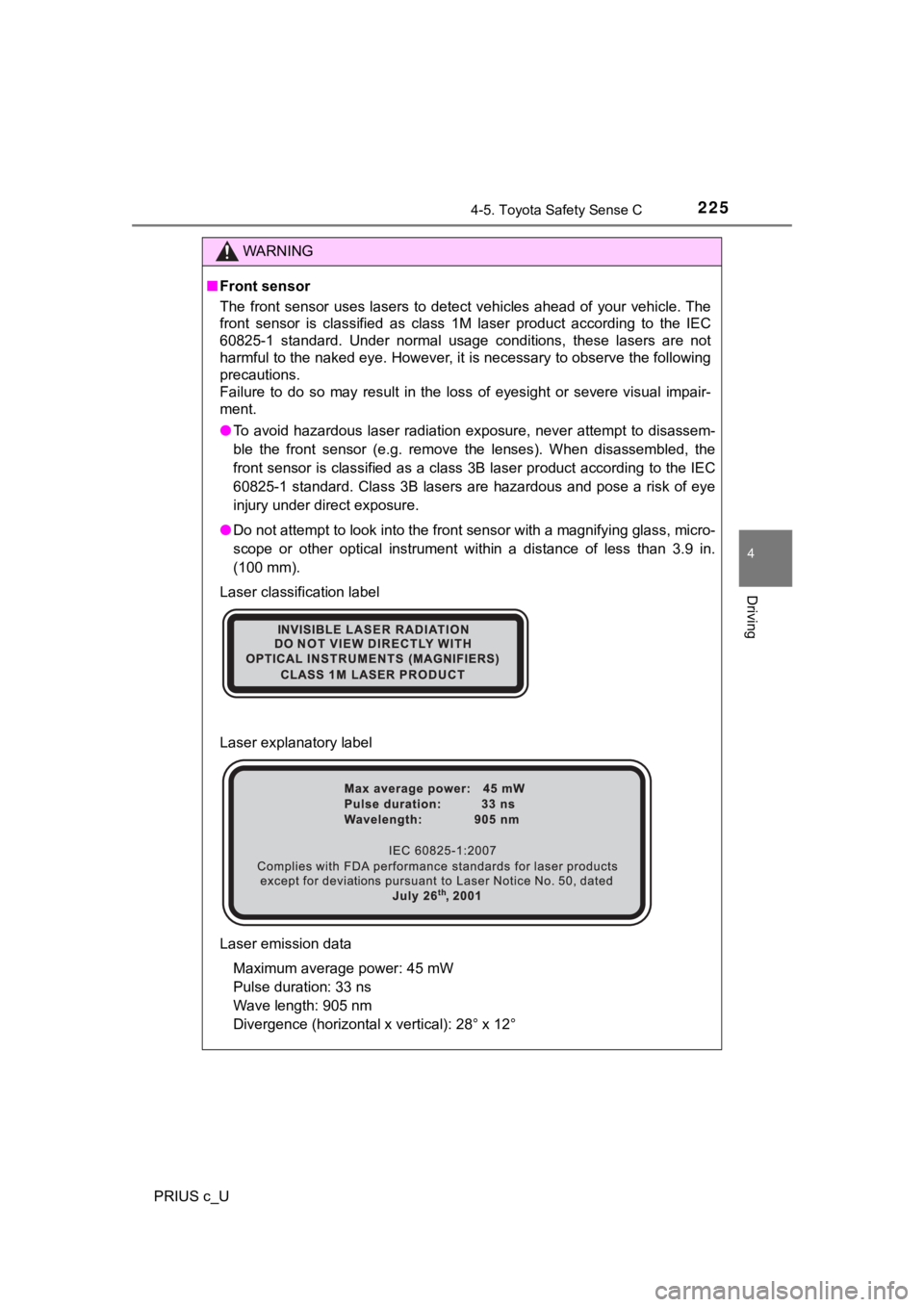
2254-5. Toyota Safety Sense C
4
Driving
PRIUS c_U
WARNING
■Front sensor
The front sensor uses lasers to detect vehicles ahead of your vehicle. The
front sensor is classified as class 1M laser product according to the IEC
60825-1 standard. Under normal usage conditions, these lasers a re not
harmful to the naked eye. However, it is necessary to observe the following
precautions.
Failure to do so may result in the loss of eyesight or severe v isual impair-
ment.
● To avoid hazardous laser radiation exposure, never attempt to d isassem-
ble the front sensor (e.g. remove the lenses). When disassemble d, the
front sensor is classified as a class 3B laser product accordin g to the IEC
60825-1 standard. Class 3B lasers are hazardous and pose a risk of eye
injury under direct exposure.
● Do not attempt to look into the front sensor with a magnifying glass, micro-
scope or other optical instrument within a distance of less tha n 3.9 in.
(100 mm).
Laser classification label
Laser explanatory label
Laser emission data Maximum average power: 45 mW
Pulse duration: 33 ns
Wave length: 905 nm
Divergence (horizontal x vertical): 28° x 12°
Page 226 of 596
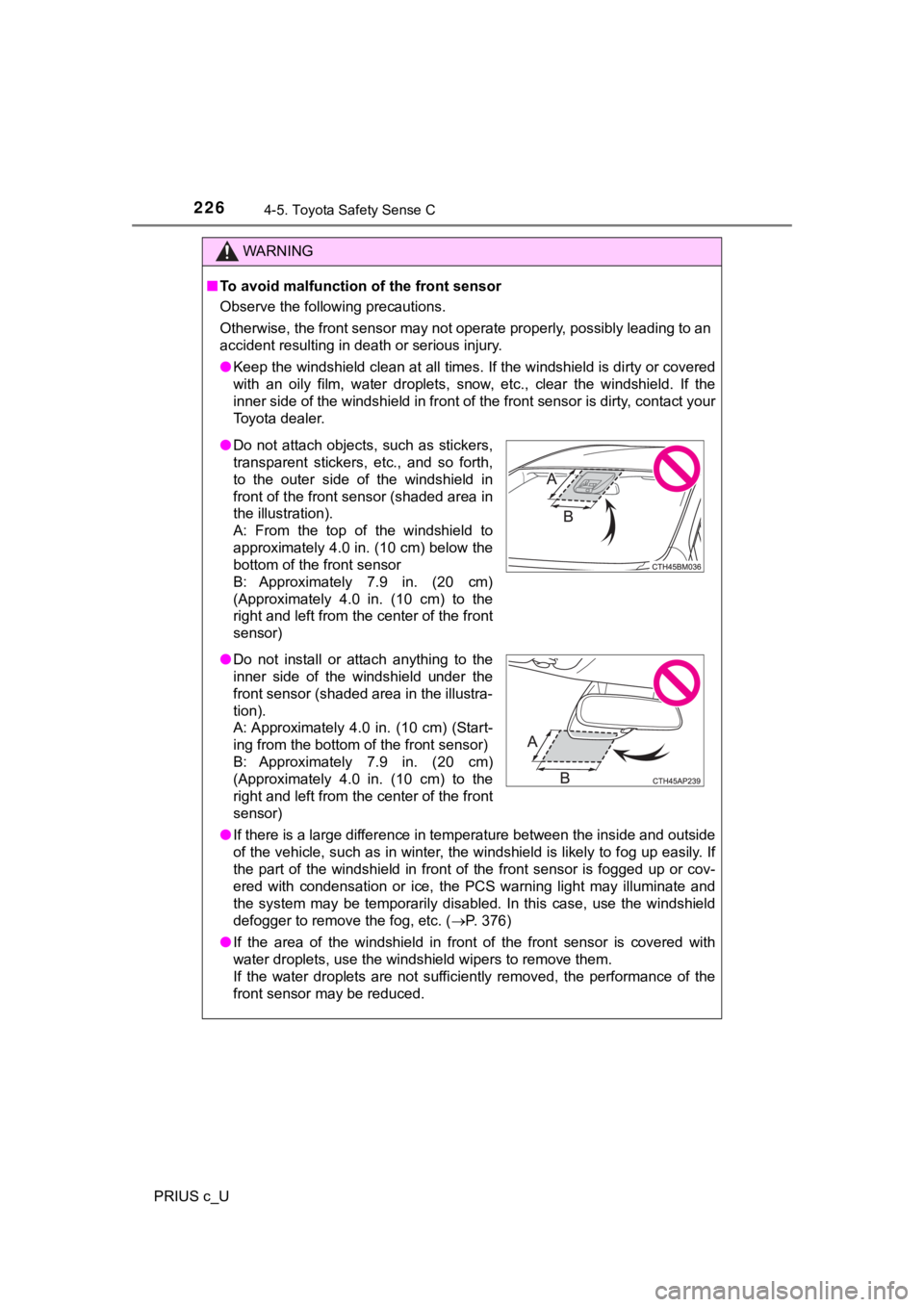
2264-5. Toyota Safety Sense C
PRIUS c_U
WARNING
■To avoid malfunction of the front sensor
Observe the following precautions.
Otherwise, the front sensor may not operate properly, possibly leading to an
accident resulting in death or serious injury.
● Keep the windshield clean at all times. If the windshield is di rty or covered
with an oily film, water droplets, snow, etc., clear the windshield. If the
inner side of the windshield in front of the front sensor is dirty, contact your
Toyota dealer.
● If there is a large difference in temperature between the inside and outside
of the vehicle, such as in winter, the windshield is likely to fog up easily. If
the part of the windshield in front of the front sensor is fogg ed up or cov-
ered with condensation or ice, the PCS warning light may illumi nate and
the system may be temporarily disabled. In this case, use the w indshield
defogger to remove the fog, etc. ( P. 376)
● If the area of the windshield in front of the front sensor is covered with
water droplets, use the windshield wipers to remove them.
If the water droplets are not sufficiently removed, the performance of the
front sensor may be reduced.
●Do not attach objects, such as stickers,
transparent stickers, etc., and so forth,
to the outer side of the windshield in
front of the front sensor (shaded area in
the illustration).
A: From the top of the windshield to
approximately 4.0 in. (10 cm) below the
bottom of the front sensor
B: Approximately 7.9 in. (20 cm)
(Approximately 4.0 in. (10 cm) to the
right and left from the center of the front
sensor)
● Do not install or attach anything to the
inner side of the windshield under the
front sensor (shaded area in the illustra-
tion).
A: Approximately 4.0 in. (10 cm) (Start-
ing from the bottom of the front sensor)
B: Approximately 7.9 in. (20 cm)
(Approximately 4.0 in. (10 cm) to the
right and left from the center of the front
sensor)
Page 227 of 596
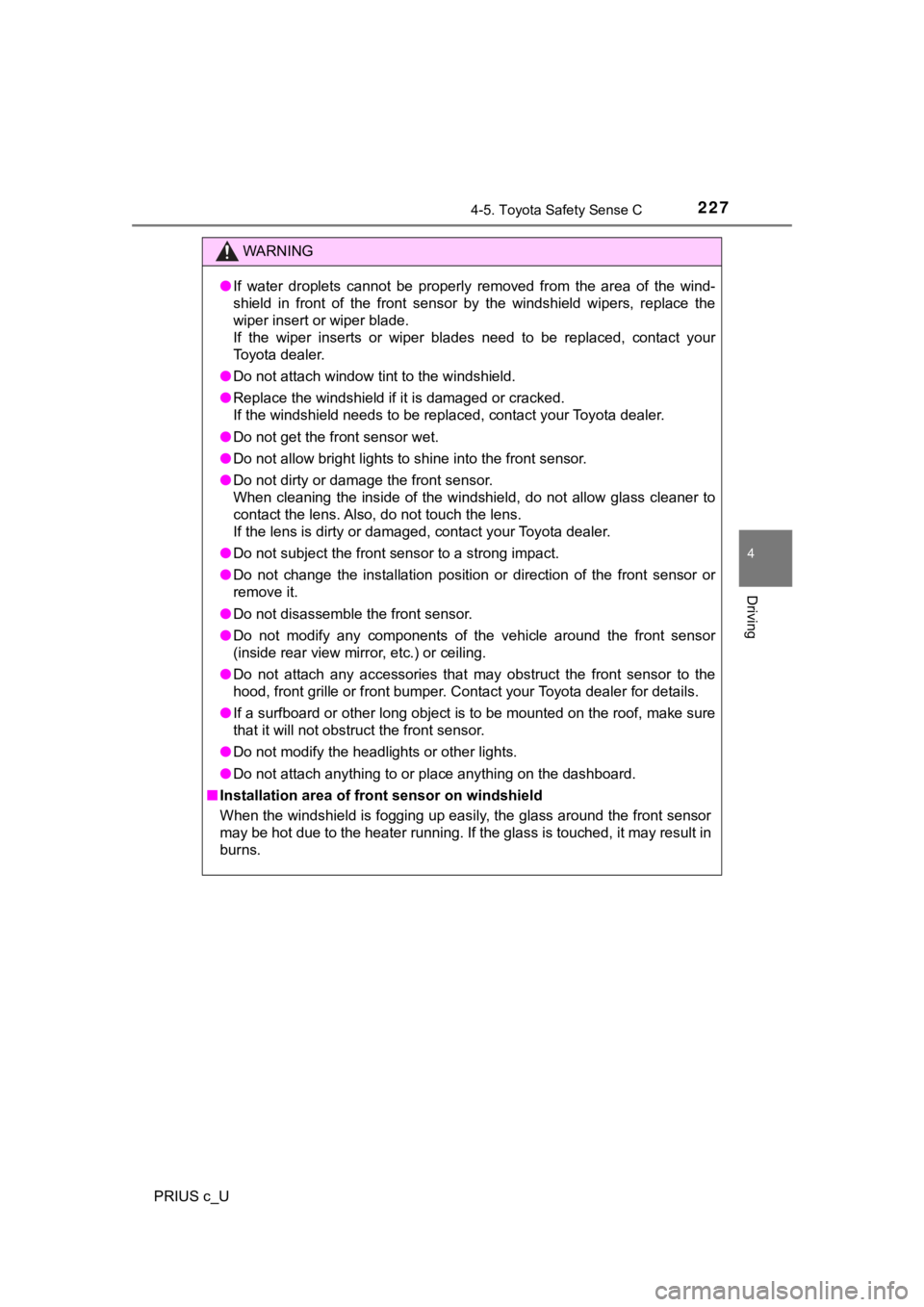
2274-5. Toyota Safety Sense C
4
Driving
PRIUS c_U
WARNING
●If water droplets cannot be properly removed from the area of t he wind-
shield in front of the front sensor by the windshield wipers, r eplace the
wiper insert or wiper blade.
If the wiper inserts or wiper blades need to be replaced, contact your
Toyota dealer.
● Do not attach window tint to the windshield.
● Replace the windshield if it is damaged or cracked.
If the windshield needs to be replaced, contact your Toyota dea ler.
● Do not get the front sensor wet.
● Do not allow bright lights to shine into the front sensor.
● Do not dirty or damage the front sensor.
When cleaning the inside of the windshield, do not allow glass cleaner to
contact the lens. Also, do not touch the lens.
If the lens is dirty or damaged, contact your Toyota dealer.
● Do not subject the front sensor to a strong impact.
● Do not change the installation position or direction of the fro nt sensor or
remove it.
● Do not disassemble the front sensor.
● Do not modify any components of the vehicle around the front sensor
(inside rear view mirror, etc.) or ceiling.
● Do not attach any accessories that may obstruct the front senso r to the
hood, front grille or front bumper. Contact your Toyota dealer for details.
● If a surfboard or other long object is to be mounted on the roo f, make sure
that it will not obstruct the front sensor.
● Do not modify the headlights or other lights.
● Do not attach anything to or place anything on the dashboard.
■ Installation area of front sensor on windshield
When the windshield is fogging up easily, the glass around the front sensor
may be hot due to the heater running. If the glass is touched, it may result in
burns.
Page 228 of 596
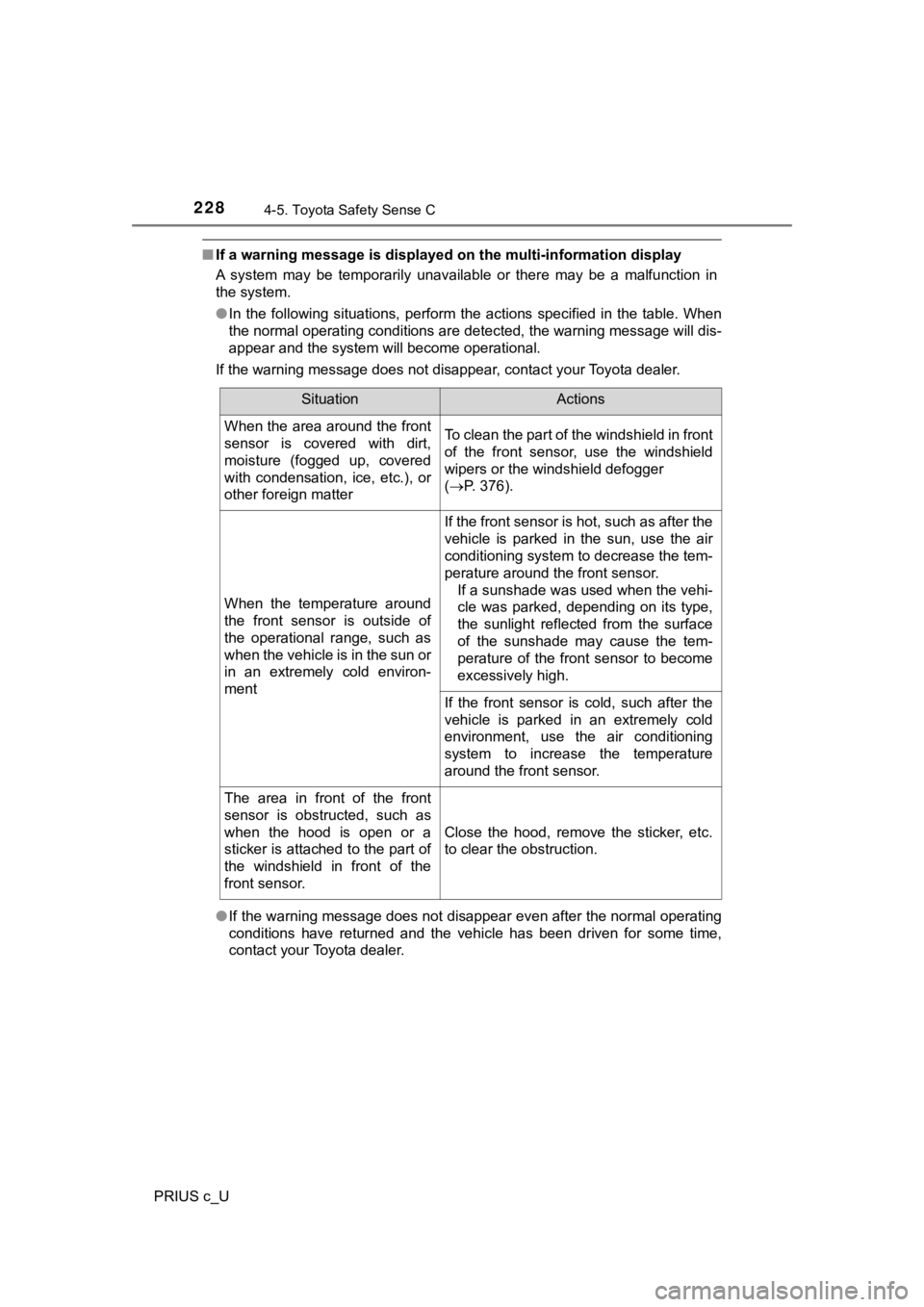
2284-5. Toyota Safety Sense C
PRIUS c_U
■If a warning message is displayed on the multi-information disp lay
A system may be temporarily unavailable or there may be a malfu nction in
the system.
● In the following situations, perform the actions specified in t he table. When
the normal operating conditions are detected, the warning messa ge will dis-
appear and the system will become operational.
If the warning message does not disappear, contact your Toyota dealer.
● If the warning message does not disappear even after the normal operating
conditions have returned and the vehicle has been driven for so me time,
contact your Toyota dealer.
SituationActions
When the area around the front
sensor is covered with dirt,
moisture (fogged up, covered
with condensation, ice, etc.), or
other foreign matterTo clean the part of the windshield in front
of the front sensor, use the windshield
wipers or the windshield defogger
( P. 376).
When the temperature around
the front sensor is outside of
the operational range, such as
when the vehicle is in the sun or
in an extremely cold environ-
ment
If the front sensor is hot, such as after the
vehicle is parked in the sun, use the air
conditioning system to decrease the tem-
perature around the front sensor.
If a sunshade was used when the vehi-
cle was parked, depending on its type,
the sunlight reflected from the surface
of the sunshade may cause the tem-
perature of the front sensor to become
excessively high.
If the front sensor is cold, such after the
vehicle is parked in an extremely cold
environment, use the air conditioning
system to increase the temperature
around the front sensor.
The area in front of the front
sensor is obstructed, such as
when the hood is open or a
sticker is attached to the part of
the windshield in front of the
front sensor.
Close the hood, remove the sticker, etc.
to clear the obstruction.
Page 229 of 596

2294-5. Toyota Safety Sense C
4
Driving
PRIUS c_U
The system can detect the following:
P. 2 3 2
● Vehicles
● Pedestrians
■Pre-collision warning
When the system determines
that the possibility of a frontal
collision is high, a buzzer will
sound and a warning message
will be displayed on the multi-
information display to urge the
driver to take evasive action.
■Pre-collision brake assist
When the system determines that the possibility of a frontal colli-
sion with a vehicle or pedestrian is high, the system applies greater
braking force in relation to how strongly the brake pedal is
depressed.
PCS (Pre-Collision System)
The pre-collision system uses the front sensor to detect objects
( P. 229) in front of the vehicle. When the system determines
that the possibility of a front al collision with an object is h igh, a
warning operates to urge the driver to take evasive action and
the potential brake pressure is increased to help the driver av oid
the collision. If the system determines that the possibility of a
frontal collision with an object i s extremely high, the brakes are
automatically applied to help av oid the collision or help reduce
the impact of the collision.
The pre-collision system can b e disabled/enabled and the warnin g
timing can be changed. ( P. 2 3 2 )
Detectable objects
System functions
Page 235 of 596
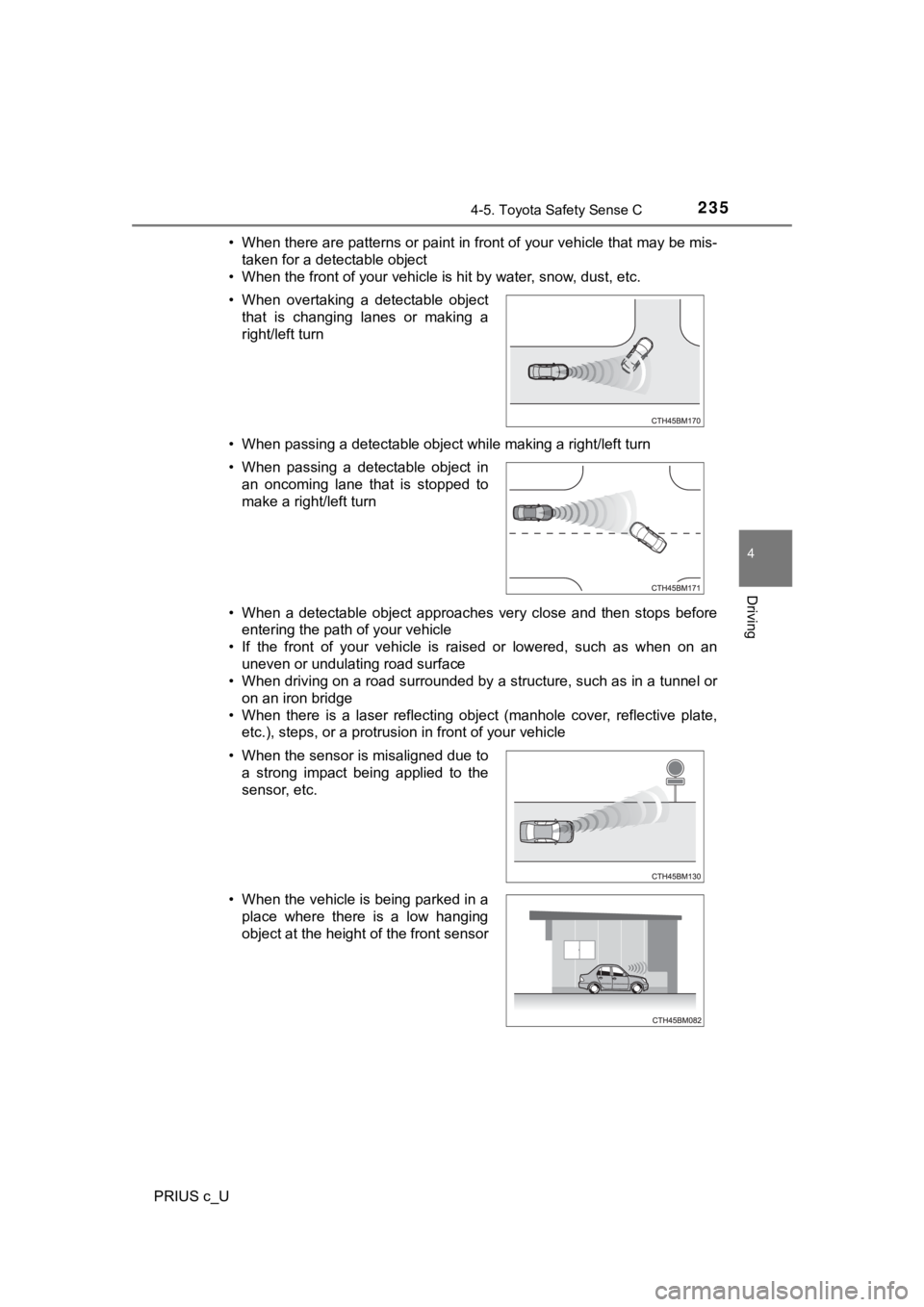
2354-5. Toyota Safety Sense C
4
Driving
PRIUS c_U• When there are patterns or paint in front of your vehicle that
may be mis-
taken for a detectable object
• When the front of your vehicle is hit by water, snow, dust, et c.
• When passing a detectable object while making a right/left tur n
• When a detectable object approaches very close and then stops before
entering the path of your vehicle
• If the front of your vehicle is raised or lowered, such as whe n on an
uneven or undulating road surface
• When driving on a road surrounded by a structure, such as in a tunnel or
on an iron bridge
• When there is a laser reflecting object (manhole cover, reflec tive plate,
etc.), steps, or a protrusion in front of your vehicle
• When overtaking a detectable object
that is changing lanes or making a
right/left turn
• When passing a detectable object in an oncoming lane that is stopped to
make a right/left turn
• When the sensor is misaligned due to a strong impact being applied to the
sensor, etc.
• When the vehicle is being parked in a place where there is a low hanging
object at the height of the front sensor
Page 236 of 596
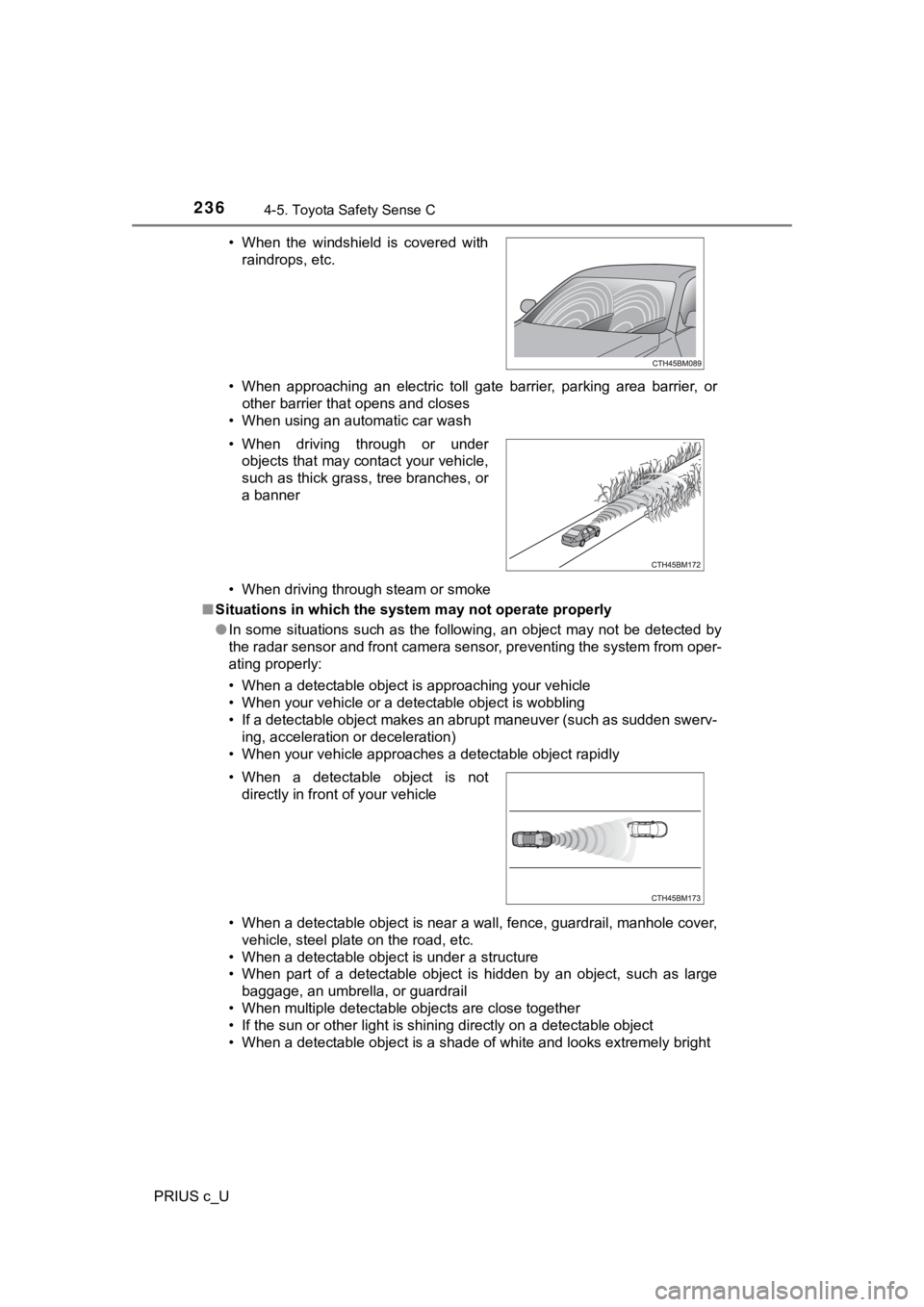
2364-5. Toyota Safety Sense C
PRIUS c_U• When approaching an electric toll gate barrier, parking area b
arrier, or
other barrier that opens and closes
• When using an automatic car wash
• When driving through steam or smoke
■ Situations in which the syst em may not operate properly
● In some situations such as the following, an object may not be detected by
the radar sensor and front camera sensor, preventing the system from oper-
ating properly:
• When a detectable object is approaching your vehicle
• When your vehicle or a detectable object is wobbling
• If a detectable object makes an abrupt maneuver (such as sudde n swerv-
ing, acceleration or deceleration)
• When your vehicle approaches a detectable object rapidly
• When a detectable object is near a wall, fence, guardrail, manhole cover,
vehicle, steel plate on the road, etc.
• When a detectable object is under a structure
• When part of a detectable object is hidden by an object, such as large
baggage, an umbrella, or guardrail
• When multiple detectable objects are close together
• If the sun or other light is shining directly on a detectable object
• When a detectable object is a shade of white and looks extreme ly bright
• When the windshield is covered with
raindrops, etc.
• When driving through or under objects that may contact your vehicle,
such as thick grass, tree branches, or
a banner
• When a detectable object is not directly in front of your vehicle
Page 237 of 596
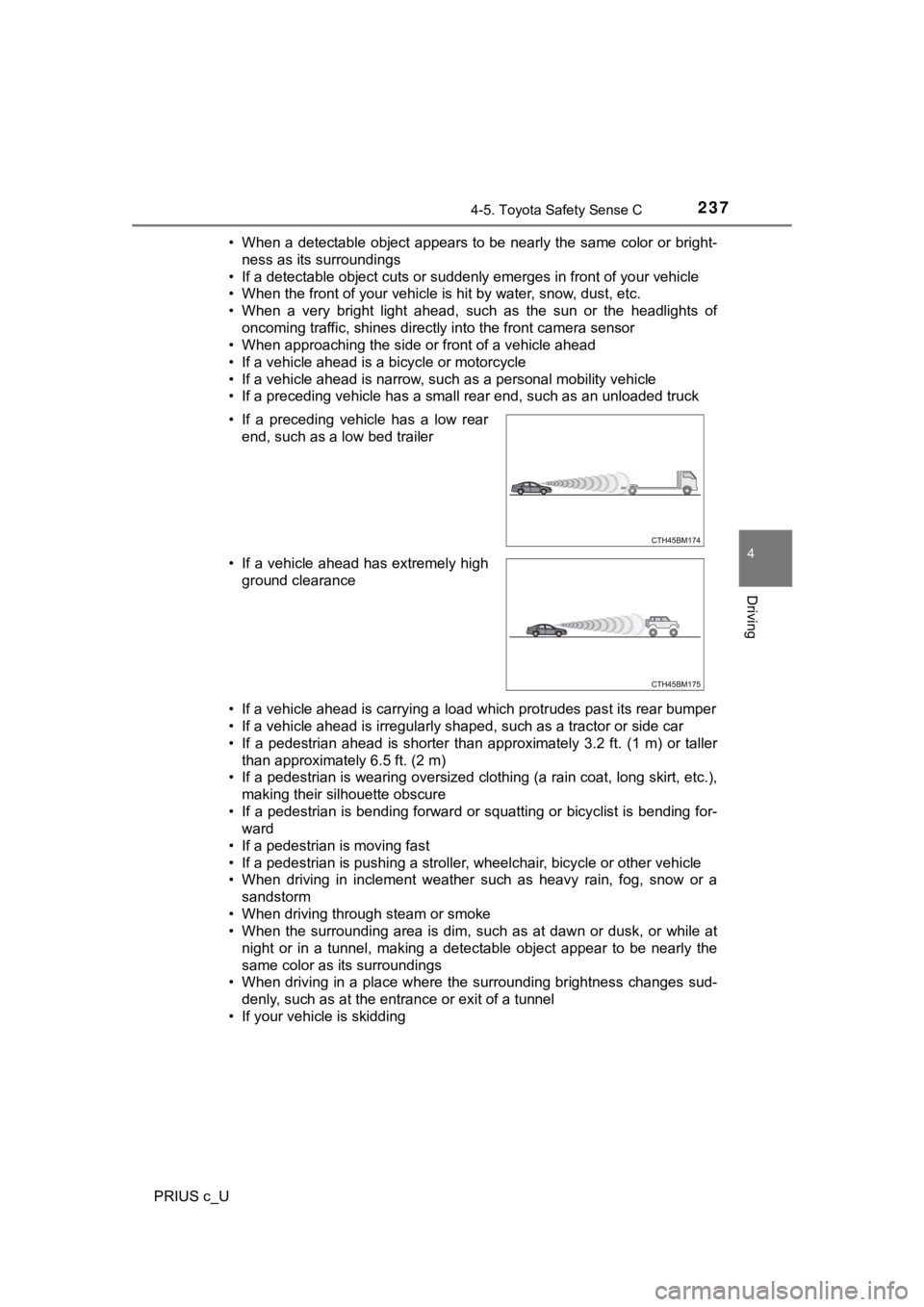
2374-5. Toyota Safety Sense C
4
Driving
PRIUS c_U• When a detectable object appears to be nearly the same color o
r bright-
ness as its surroundings
• If a detectable object cuts or suddenly emerges in front of your vehicle
• When the front of your vehicle is hit by water, snow, dust, et c.
• When a very bright light ahead, such as the sun or the headlig hts of
oncoming traffic, shines directly into the front camera sensor
• When approaching the side or front of a vehicle ahead
• If a vehicle ahead is a bicycle or motorcycle
• If a vehicle ahead is narrow, such as a personal mobility vehi cle
• If a preceding vehicle has a small rear end, such as an unload ed truck
• If a vehicle ahead is carrying a load which protrudes past its rear bumper
• If a vehicle ahead is irregularly shaped, such as a tractor or side car
• If a pedestrian ahead is shorter than approximately 3.2 ft. (1 m) or taller
than approximately 6.5 ft. (2 m)
• If a pedestrian is wearing oversized clothing (a rain coat, lo ng skirt, etc.),
making their silhouette obscure
• If a pedestrian is bending forward or squatting or bicyclist i s bending for-
ward
• If a pedestrian is moving fast
• If a pedestrian is pushing a stroller, wheelchair, bicycle or other vehicle
• When driving in inclement weather such as heavy rain, fog, snow or a sandstorm
• When driving through steam or smoke
• When the surrounding area is dim, such as at dawn or dusk, or while at
night or in a tunnel, making a detectable object appear to be n early the
same color as its surroundings
• When driving in a place where the surrounding brightness changes sud- denly, such as at the entrance or exit of a tunnel
• If your vehicle is skidding • If a preceding vehicle has a low rear end, such as a low bed trailer
• If a vehicle ahead has extremely high ground clearance
Page 238 of 596
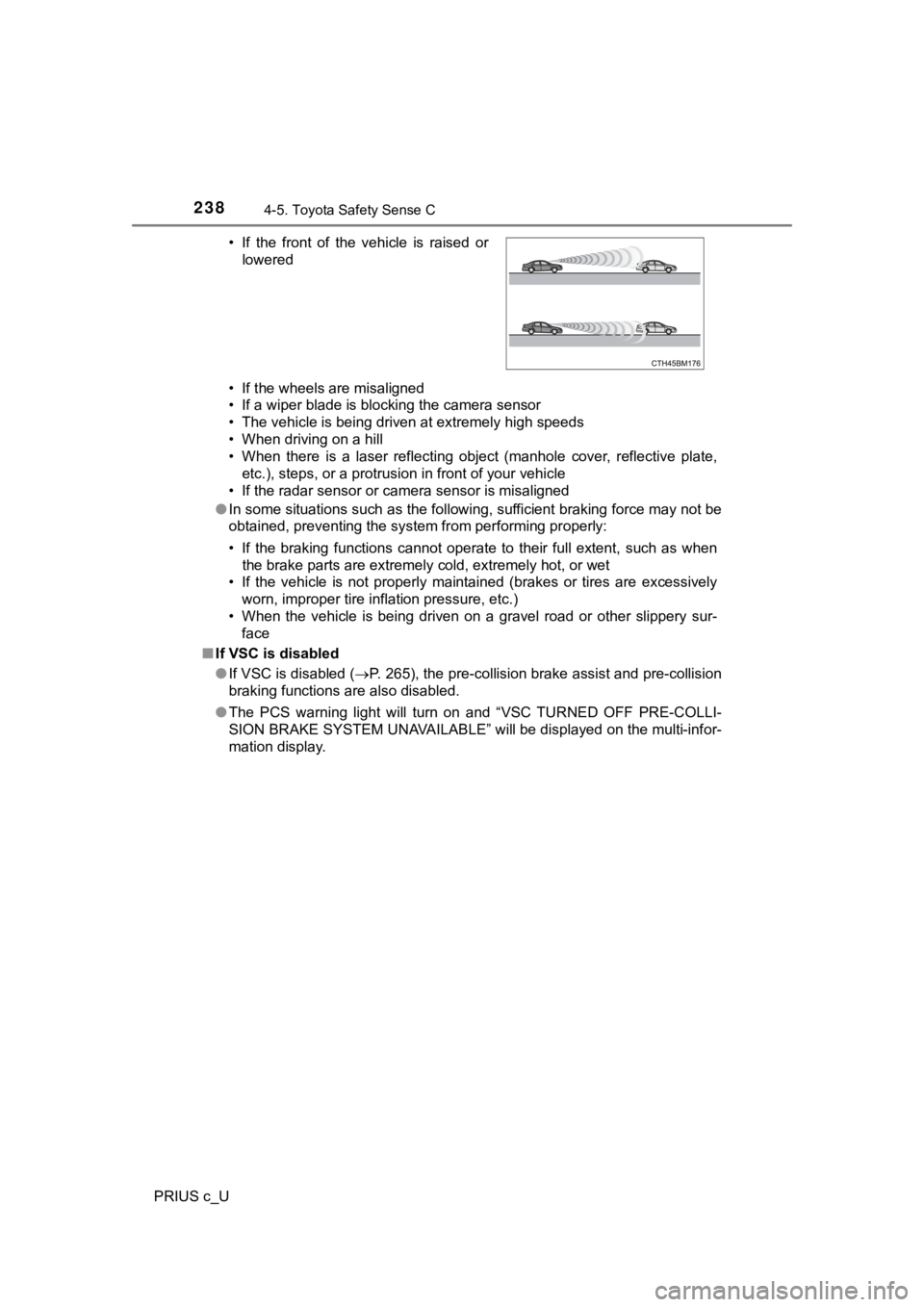
2384-5. Toyota Safety Sense C
PRIUS c_U• If the wheels are misaligned
• If a wiper blade is blocking the camera sensor
• The vehicle is being driven at extremely high speeds
• When driving on a hill
• When there is a laser reflecting object (manhole cover, reflec
tive plate,
etc.), steps, or a protrusion in front of your vehicle
• If the radar sensor or camera sensor is misaligned
● In some situations such as the following, sufficient braking fo rce may not be
obtained, preventing the system from performing properly:
• If the braking functions cannot operate to their full extent, such as when
the brake parts are extremely cold, extremely hot, or wet
• If the vehicle is not properly maintained (brakes or tires are excessively
worn, improper tire inflation pressure, etc.)
• When the vehicle is being driven on a gravel road or other sli ppery sur-
face
■ If VSC is disabled
●If VSC is disabled ( P. 265), the pre-collision brake assist and pre-collision
braking functions are also disabled.
● The PCS warning light will turn on and “VSC TURNED OFF PRE-COLL I-
SION BRAKE SYSTEM UNAVAILABLE” will be displayed on the multi-i nfor-
mation display. • If the front of the vehicle is raised or
lowered
Page 239 of 596

2394-5. Toyota Safety Sense C
4
Driving
PRIUS c_U
When driving on roads with white (yellow) lines, this function alerts the
driver when the vehicle mi ght depart from its lane.
The LDA system recognizes visi-
ble white (yellow) lines with the
front sensor on the upper portion
of the front windshield.
When the system determines that
the vehicle might depart from its
lane, a warning is displayed on
the multi-information display and
the warning buzzer sounds to
alert the driver.
When the warning buzzer sounds,
check the surrounding road situa-
tion and carefully operate the
steering wheel to move the vehicle
back to the center within the white
(yellow) lines.
LDA (Lane Depar ture Alert)
Summary of function
Lane departure alert function